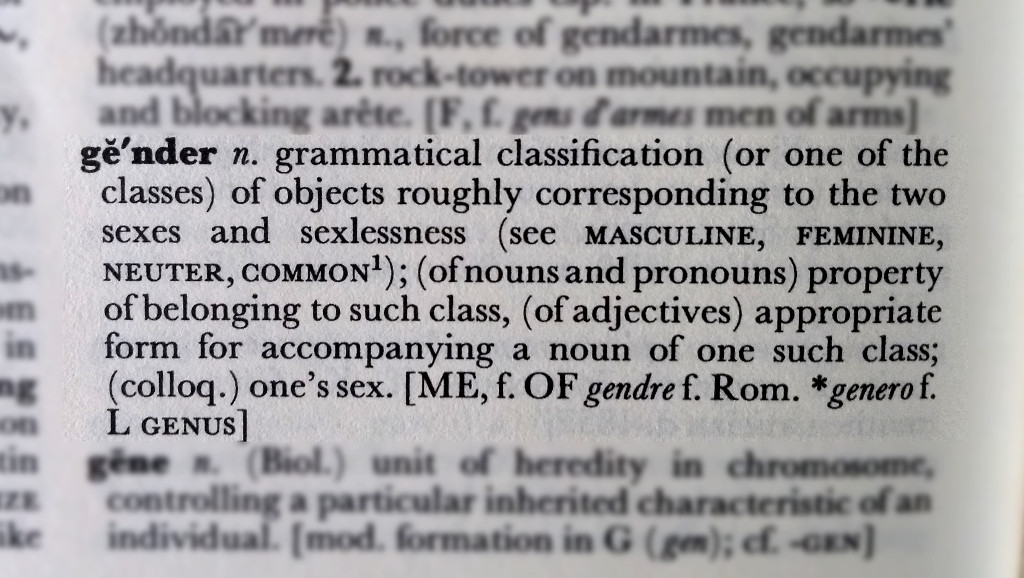It is most important that clear and accurate language is used when discussing issues surrounding the transgender phenomenon. The language used by those who are promoting transgenderism, for whatever reason, is often deliberately misleading and obfuscatory. For example, a ‘trans woman’ in their lexicon is not actually a woman (adult human female).
We encourage everyone to avoid the neologisms of those who are corrupting our young with their toxic ideas. The idea that anyone is ‘cis’ is one that is utterly unnecessary. A woman is a woman and that is not changed by her adopting masculine stereotypes.
Through our work, we have started to adopt terms of our own which we feel more accurately describe our collective experiences. This, then, is a glossary of our terms:
Opposite Sex Imitation
Persons with transgender ideation will most often seek to imitate the opposite sex. Without any medical intervention, this is merely crossdressing. When there is medical intervention, we refer to it as Opposite Sex Imitation Medicine or OSIM. This is what others might call ‘gender affirming care‘. The problem with that phrase is that is establishes the concept of gender as a human attribute, presupposes that incongruent gender identities need to be affirmed, and describes harmful medical malpractice as ‘care’. Opposite Sex Imitation is more accurate: there are only two sexes, it is only ever possible to imitate the opposite sex (rarely convincingly). This, therefore is a neutral term devoid of weaselly gaslighting.
Transgender Ideation
People who think of themselves as the opposite sex are considered in modern parlance to ‘be’ transgender. However, there is no diagnostic test, and any consensus which might exist for what being transgender might be is that it is a feeling. Often, it is assumed that a person feeling themselves to be transgender must have ‘gender dysphoria’ – a deep unease with the reality of their sex. However, not every person who expresses a transgender identity has gender dysphoria.
From UK NHS:
The term used to describe a discrepancy between birth-assigned sex and
https://www.england.nhs.uk/wp-content/uploads/2019/07/service-specification-gender-dysphoria-services-non-surgical-june-2019.pdf
gender identity is gender incongruence; this term is preferable to the
formerly-used terms of gender identity disorder and transsexualism. Gender
incongruence is frequently, but not universally, accompanied by the symptom
of gender dysphoria.
Note the use of the phrase ‘birth-assigned sex’. Sex is not ever assigned at birth – it exists from conception – and is observed. This is just one of the signs that the National Health Service in UK has been ‘cognitively captured’ by those promoting gender ideology, and why we advise UK parents of children with transgender ideation to avoid the NHS.
It is particularly the case with adolescents that they have become fixated upon the idea that they need to imitate the opposite sex.
It is important to understand that when young people start ruminating on this idea it is because the idea was provided by a third-party. There might be nothing that can be done to prevent children getting the idea in the first place – but it is most imperative that the idea that a person might be transgender is given no validity whatsoever. The people promoting the idea are also giving the idea a status which it does not deserve. Of course, schools can teach children that some people live their lives imitating the opposite sex; however, should a child express a desire to do so themselves then it is a clear safeguarding failure. Opposite Sex Imitation is both psychologically and physiologically harmful. Having the idea is fine, however it should be readily dismissed. If a child persists with the idea through excessive rumination (and encouraged by bad actors) then they need help to rid themselves of such a ridiculous notion. This is why Our Duty argues for the medical professions to target 100% desistance in cases of transgender ideation.
Transgender ideation can be equated with suicidal ideation. Both are maladaptive coping mechanisms, both can come about through excessive rumination, both can be triggered by anxiety or depression, etc. etc. Using the term transgender ideation removes any suggestion that it is somehow ‘innate’. Our kids get a stupid idea in their head. They get it from somewhere (hence social contagion). Telling a kid “you might be trans” is of similar morality to telling them “suicide might be an option”.
When our kids claim to be transgender, they have transgender ideation.

